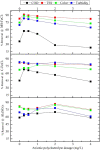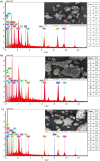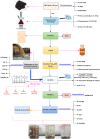Green industry work: production of FeCl3 from iron and steel industry waste (mill scale) and its use in wastewater treatment
- PMID: 38367113
- PMCID: PMC10927800
- DOI: 10.1007/s11356-024-32451-6
Green industry work: production of FeCl3 from iron and steel industry waste (mill scale) and its use in wastewater treatment
Abstract
Mill scale (MS) is considered to be a significant metallurgical waste, but there is no economical method yet to utilize its metal content. In this study, which covers various processes in several stages, the solution of iron in MS, which is the Iron and Steel Industry (I&SI) waste, as FeCl3 (MS-FeCl3) in the thermoreactor in the presence of HCl, was investigated. In the next step, the conditions for using this solution as a coagulant in the treatment of I&SI wastewater were investigated using the jar test. The results of the treated water sample were compared by chemical oxygen demand (COD), total suspended solids (TSS), color, and turbidity analyses using commercial aluminum sulfate (Al2(SO4)3) and FeCl3 (C-FeCl3). Additionally, heavy metal analyses were conducted, and the treatment performance of three coagulants was presented. Accordingly, while 2.0 mg/L anionic polyelectrolyte was consumed at a dosage of 4.05 mg/L Al2(SO4)3 at pH 7.0, 0.25 mg/L anionic polyelectrolyte was consumed at a dosage of 1.29 mg/L at pH 5.0 in the C-FeCl3 and MS-FeCl3 studies. Also, Fe, Cr, Mn, Ni, Zn, Cd, Hg, and Pb removal efficiencies were over 93.56% for all three coagulant usage cases. The results showed that the wastewater treatment performance of MS-FeCl3 by the recycling of MS, which is an I&SI waste, was at the same level as C-FeCl3. Thus, thanks to recycling, waste scale can be used as an alternative to commercial products for green production.
Keywords: Coagulation-flocculation; FeCl3 production; Heavy metal; Iron and steel wastewater; Mill scale.
© 2024. The Author(s).
Conflict of interest statement
The authors declare no competing interests.
Figures










Similar articles
-
A holistic approach to the recovery of valuable substances from the treatment sludge formed from chemical precipitation of fruit processing industry wastewater.Sci Total Environ. 2024 Mar 20;917:170372. doi: 10.1016/j.scitotenv.2024.170372. Epub 2024 Jan 26. Sci Total Environ. 2024. PMID: 38280603
-
Chemical oxygen demand (COD) reduction in wastewater from the textile industry by coagulation-flocculation and adsorption.Environ Monit Assess. 2025 Apr 10;197(5):536. doi: 10.1007/s10661-025-13987-7. Environ Monit Assess. 2025. PMID: 40210808
-
The effect of pre-treatment methods on membrane flux, COD, and total phenol removal efficiencies for membrane treatment of pistachio wastewater.J Environ Manage. 2022 May 15;310:114762. doi: 10.1016/j.jenvman.2022.114762. Epub 2022 Feb 24. J Environ Manage. 2022. PMID: 35220102
-
Advancement of biochar-aided with iron chloride for contaminants removal from wastewater and biogas production: A review.Sci Total Environ. 2023 May 20;874:162437. doi: 10.1016/j.scitotenv.2023.162437. Epub 2023 Feb 28. Sci Total Environ. 2023. PMID: 36858210 Review.
-
Combination of coagulation and adsorption technologies for advanced wastewater treatment for potable water reuse: By ANN, NSGA-II, and RSM.J Environ Manage. 2023 Oct 28;349:119429. doi: 10.1016/j.jenvman.2023.119429. Online ahead of print. J Environ Manage. 2023. PMID: 39491942 Review.
References
-
- Abujazar MSS, Karaağaç SU, Abu Amr SS, et al. Recent advancement in the application of hybrid coagulants in coagulation-flocculation of wastewater: a review. J Clean Prod. 2022;345:131133. doi: 10.1016/J.JCLEPRO.2022.131133. - DOI
-
- Abujazar MSS, Karaağaç SU, Amr SSA, et al. The effectiveness of rosehip seeds powder as a plant-based natural coagulant for sustainable treatment of steel industries wastewater. Desalination Water Treat. 2022;270:44–51. doi: 10.5004/DWT.2022.28782. - DOI
-
- Akbal F, Camci S. Comparison of electrocoagulation and chemical coagulation for heavy metal removal. Chem Eng Technol. 2010;33:1655–1664. doi: 10.1002/CEAT.201000091. - DOI
MeSH terms
Substances
LinkOut - more resources
Full Text Sources

